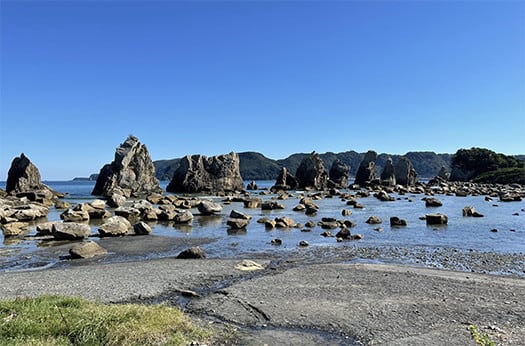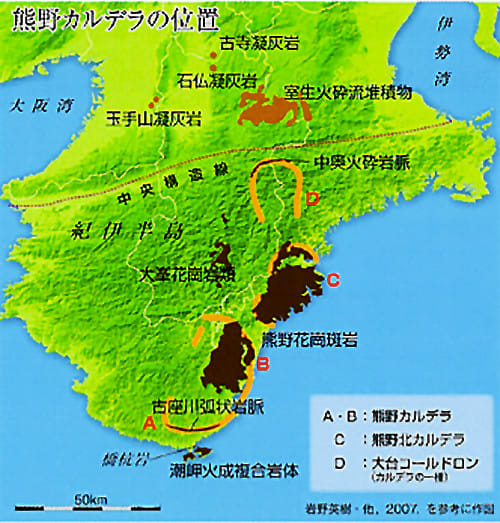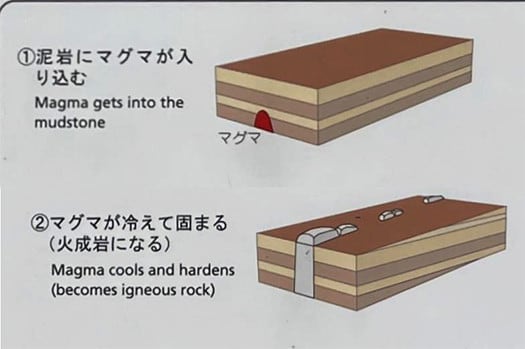


熊野地域の中心都市・新宮市は特異な地形と歴史年代での「熊野信仰」という独自の文化性についての研究を促進するために「熊野学」というカテゴリーを立ち上げ、公共自治体として学会などの活動をバックアップしている。こちらがそのHP。
大阪の伊丹空港で「熊野に行くんです」とレンタカー屋さんで車を借りるときスタッフの若い方に言ったとき「熊野ってどこですか?」と問い返された。京阪神地域ではそういう認識なんだと知らされた。言外に「わざわざ北海道から来た人が」という響きもあったほど。それくらい紀伊南部は関西圏でも「遠い」地域なのでしょうね。関西中央からはかなり遠隔な自治体としてこうした熱意ある取り組みには、北海道人としてもエールを送りたくなる。
一説では1500万年前の地球規模でも最大級のカルデラ噴火がこの地域で発生して、特異な地形が形成されたとされている。「熊野カルデラ」とWikiで参照するとこうした「世界最大級」という情報が出てくるけれど、公共の立場からはまだ学会的に公知とされてはいないというスタンス。
しかし、特異なカルデラ地形が紀伊地域の太平洋岸一体で形成されていることは事実。このような地質学的な検証は冷静に進んでいただきたいと思います。
こうした地球的な火山活動の一端は、和歌山県東牟婁郡串本町の「橋杭岩」(2枚目の写真)の生成メカニズム解説でわかる。以下がその解説図面。


こういった地球レベルのカルデラ活動が造形した自然景観に対して、古代の人びとはどんな印象を抱いたかと考えれば、熊野詣の意味合いがわかりやすく伝わってくる。自然科学の基礎知識が下地にない状態でこうした景観に接すれば、熊野信仰という民族的「昇華」が符合すると気付く。
そしてさらに国生み神話などとの相互作用があったとも想像できる。イザナギ・イザナミにちなんだ象徴的ポイントが熊野各地に刻印されていくことになった。そういった流れで、逆に神武天皇の「東征」経路としてこの熊野の地がアナロジーされたのだとも類推される。
このあたりは神話の霧に包まれていて、凡百としては探究の仕様がない。ただ、神武東征がなんらかの事実の痕跡であるのなら、この熊野を上陸地点にしたというその構想力は素晴らしい。世界の皇統神話のなかでバツグンのレベルではないかと思わされる。そして生成期から日本の皇統が「民のために祈る」存在であり続けたことと併せ、非常に着眼点がすごいことだと思う。
世界の王統神話がほとんどその「出生」時を以て始原とするのに対して、日本の皇統は「神武帝の即位」を以て始原としていることも特異的だとされる。あくまでも統治の正当性ということが主眼であって必ずしも血の神聖性が根拠ではないのだと。
そして万人が納得せざるを得ない自然造形の特異性が、皇統神話に強い説得力を持ったことは間違いない。いよいよ、神武東征の熊野からという経路に興味が深まっていくのですね。
English version⬇
Caldera Topography and Ancient Faith: Imperial Mythology and Kumano Journey-4
The Kumano faith, which has instilled a sense of "samoarinann" even in the myth of the birth of the nation. Persuasive power that far exceeds the world's royal myths. ...
Shingu City, the central city of the Kumano region, has established the category of "Kumano Studies" to promote research on the unique cultural nature of "Kumano worship" in its unique topography and historical age, and is backing up the activities of academic societies and other organizations as a public municipalityこちらがそのHP。
When I told a young staff member at Itami Airport in Osaka that I was going to Kumano when I rented a car at a car rental shop, he asked me, "Where is Kumano?" He asked me "Where is Kumano? I was informed that this was the perception in the Keihanshin region. He even said, "Someone came all the way from Hokkaido. That must be how "remote" the southern part of Kii is, even in the Kansai region. As a Hokkaido native, I would like to send my encouragement to such enthusiastic efforts by a municipality that is quite remote from the central Kansai region.
One theory is that one of the largest caldera eruptions on a global scale occurred in this area 15 million years ago, forming a unique topography. When you refer to "Kumano caldera" on Wiki, you will find information about this "world's largest caldera," but from a public standpoint, the stance is that it is not yet public knowledge in the academic world.
However, it is a fact that a unique caldera topography is formed on the Pacific coast of the Kii area. We hope that such geological verification will proceed calmly.
One aspect of such global volcanic activity can be seen in the explanation of the formation mechanism of "Hashikaiwa" (second photo) in Kushimoto-cho, Higashimuro-gun, Wakayama Prefecture. The following is the explanatory drawing.
If we consider what kind of impression ancient people had on these natural landscapes formed by caldera activities on a global level, we can easily understand the meaning of Kumano pilgrimage. If one comes in contact with such landscapes without a basic knowledge of natural science, he or she will realize that the Kumano worship is a nationalistic "sublimation" that is consistent with the Kumano faith.
We can also imagine that there was an interaction with the myth of the birth of the nation. Symbolic points associated with Izanagi-Izanami were imprinted all over Kumano. In this way, it is analogous that the Kumano area was analogized as the route of Emperor Jinmu's "Eastern Expedition" to Japan.
This area is shrouded in a fog of mythology, and as a layman, I have no way to explore it. However, if the Jinmu Expedition is some trace of fact, the conception of Kumano as a landing site is impressive. It is one of the most outstanding myths of the imperial lineage in the world. The fact that the Japanese imperial lineage has been "praying for the people" from the time of its creation is also a very impressive point of view.
It is also unique in that, while most of the world's royal myths date their origin from the time of birth, the Japanese imperial lineage dates from the "accession of the Emperor Jinmu. The main focus is on the legitimacy of the rule, not necessarily on the sanctity of blood.
The uniqueness of the natural formations, which everyone had to agree on, was undoubtedly a strong persuasive force in the myth of the imperial lineage. Finally, we are becoming more and more interested in the route of the Jinmu expedition from Kumano, aren't we?



















